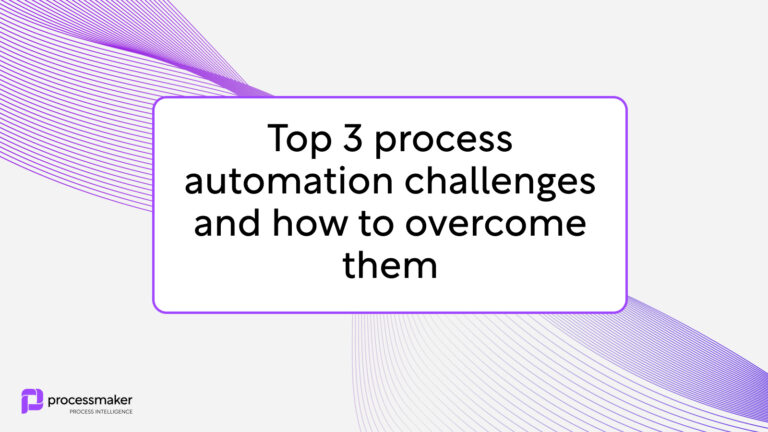Intelligent automation is transforming business operations by enhancing productivity, efficiency, and accuracy. However, this shift comes with its own set of challenges. Implementing automation solutions can be intricate, and various obstacles must be navigated to fully realize their benefits. In this article, we will examine some of the primary challenges associated with process automation that businesses encounter and offer practical solutions to address them effectively.
What is process automation?
Process automation utilizes technology to automatically execute repetitive tasks and procedures, minimizing the necessity for human involvement. This automation can be applied across a range of business functions, including finance, human resources, supply chain management, and customer service.
Three key reasons process automation projects fail
It could have been ideal if companies fully understood the reasons for implementing automation in the workplace, the desired outcomes, and the steps needed to achieve them. However, the reality often falls short of this vision, as various external factors significantly influence an organization’s transformation process.
1. Organizational change fatigue
The primary challenge that hinders companies in their digital transformation journey is the all-too-familiar weight of change fatigue. Change, a natural part of our human experience, often feels daunting, especially when past management shifts have left scars of uncertainty.
What often frightens people the most is the uncertainty tied to transitional phases. A helpful approach to managing this anxiety is to clearly communicate all forthcoming changes to employees. It’s essential for everyone in the organization to understand the value these changes bring. When individuals are unclear about the “why” behind the shifts, their willingness to engage diminishes.
How can leadership facilitate a smoother transition during this process? They should proactively introduce significant changes well in advance, engaging everyone impacted by the shift. By planning for upcoming changes, guiding individuals through each stage, soliciting their feedback, and ensuring a sense of mental safety, leaders can make the automation initiatives far more manageable. While these steps may seem basic, they play a crucial role in easing the transition.
2. Disjointed business processes
One significant barrier to effective automation efforts is the fragmentation of processes. When companies pilot or implement automation initiatives, different departments and units often operate as isolated entities. While this separation is understandable for department-specific changes, the absence of organization-wide process unification can complicate the entire automation endeavor, leading to chaos. Utilizing random tools and automating processes “here and there” may create even greater gaps in the system.
To address this issue, companies should first examine how work is currently performed. Understanding your starting point makes it easier to determine the right direction. Once there is a clear overview of existing operations and the most pressing problems are identified, it becomes simpler to prioritize changes that will yield the highest impact.
3. Lack of readiness for a new work reality
An apparent yet challenging factor is the lack of readiness for change. The new work environment, where humans collaborate with robots and AI, demands a different approach and mindset from both leadership and employees. Soon, every modern team or unit will consist of both traditional and digital workforces, working together on projects and enhancing each other’s capabilities. This shift means that employees will need to be adaptable and quick to learn, while hiring for automation projects may become slow and difficult.
It is crucial to understand that robots do not replace humans, at least in the foreseeable future; rather, they serve to assist and support us. Machines and robots will primarily handle low-level transactional tasks that do not demand human intelligence. As a result, individuals will have increased opportunities to engage in more creative and innovative work that is non-manual in nature.
This shift clearly demands a different skill set from employees, making upskilling essential to prepare them for significant workplace changes. Additionally, many software applications require specific qualifications and comprehensive training programs. Therefore, qualities such as open-mindedness, adaptability, and a high tolerance for ambiguity will be highly valued in employees.
Overcoming process automation challenges
Overcoming the challenges of process automation requires a holistic approach, addressing various aspects of the implementation process. Some practical solutions are:
Communication and collaboration
Effective communication and collaboration are critical to the success of automation projects. Businesses should engage with key stakeholders and employees to build consensus and reduce resistance to change. Additionally, cross-functional teams should be formed to ensure collaboration and alignment across departments.
Proper planning and execution
Proper planning and execution are critical for the success of automation projects. Businesses should develop a clear roadmap and timeline, identifying potential risks and challenges. Additionally, they should prioritize automation initiatives based on their potential impact and ROI. Process intelligence software can help you identify process automation opportunities and track progress over the course of your initiatives.
Embrace change management
A third crucial aspect to overcome process automation fatigue is a persistent effort in change management. Many people may feel threatened or frustrated by automation taking away work tasks. It’s important to communicate the benefits of process automation – as well as educate and inform employees of the ways automation can free up time and resources for more meaningful work.
Change is inevitable, but resilience and agility are a must
Regardless of the industry or location, any company with employees engaged in knowledge work will need to embrace business process automation in the coming years. It’s no longer just a nice-to-have; it’s a powerful tool that can enhance job efficiency and boost competitiveness when implemented correctly. Automation is much more than just robots assisting people; it is a whole new way of work that ensures better systems and automated workflows.
The key factor here is speed. It’s vital to have a strategic plan and a clear vision of the desired outcomes, ensuring that the company pursues automation with a purpose rather than following the crowd. Given the rapid pace of change and uncertainty, speed is essential not only to stay ahead of competitors but also to maintain sustainable growth.





